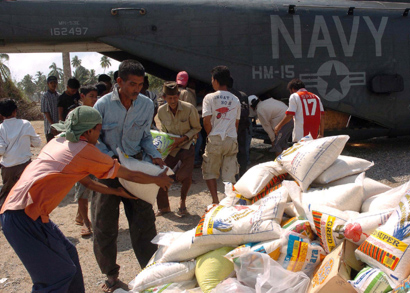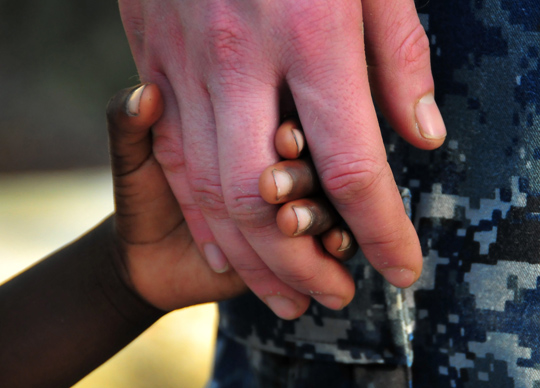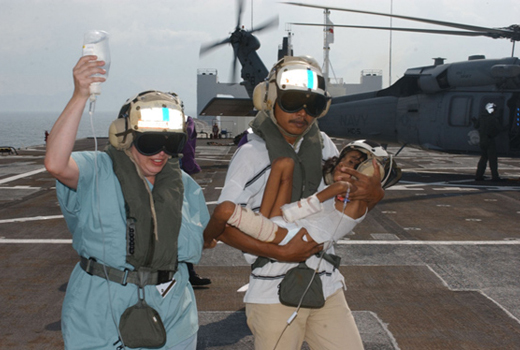Navy “Stability Ops:” Humanitarian Assistance & Disaster Relief
O“n 26 December 2004, an earthquake off Southeast Asia produced a tsunami, which resulted in the confirmed deaths of more than 130,000 people in Indonesia. The massive loss of life and injury, coupled with the almost total destruction of infrastructure, caused the United States to respond by sending a Joint Task Force to conduct humanitarian relief and disaster assistance. The operation, which was designated ‘Operation Unified Assistance,’ was able to incorporate many lessons learned from disaster relief operations from the past 13 years and to highlight new areas for improvement. Operation Unified Assistance reiterated the idea that the U.S. military can effectively contribute to large scale disaster relief operations. Ultimately, the Operation utilized more than 15,000 U.S. personnel, 25 ships and more than 100 aviation assets,” according to a 2008 paper submitted to the Naval War College by then LT Miguel R. Martinez.
Martinez’ paper maintains that “the ability to provide logistics to relief agencies and the population was a critical capability for the Operation. The Military Sealift Command (MSC) was uniquely suited to utilize the sea lines of communication to provide disaster relief supplies. . . . Another method utilized to provide support to relief agencies and the affected population was the deployment of the U.S. Navy hospital ship USNS Mercy. It provided almost 20,000 medical procedures with a staff of more than 5,000 military and non-governmental organizations (NGO). USNS Mercy staff also assisted NGOs on shore by training new hospital staff. . . The positive effect of the USNS Mercy on Operation Unified Assistance was undeniable.
“The value of sea basing was also readily apparent in Operation Unified Assistance. One of its main advantages was that it significantly lessened the American forces footprint on the island and addressed concerns among the local population that the U.S. was trying to convert Muslims or pave the way for an invasion. Sea basing was also a significant factor in operational force protection since U.S. forces did not stay ashore for long periods of time.”
The Gift of Hope
According to now retired Chief of Naval Operations Admiral Gary Roughead, Operation Unified Assistance became a watershed moment in the Navy’s understanding of what later became known as the “stability ops” of humanitarian assistance and disaster relief (HADR). According to Department of Defense Directive 3000.05, sec. 4.2, issued 2007, the short-term, immediate goal of stability operations is to provide the local populace with security, to restore essential services and to meet humanitarian needs. The long-term goal of stability operations is to help develop indigenous capacity for essential services, a viable market economy, Rule of Law, democratic institutions and a robust civil society.

U.S. Navy photo by Photographer’s Mate Airman Stephanie Lynne Johnson
Surgeon General of the Navy and Chief of the Navy’s Bureau of Medicine and Surgery, Vice Admiral Adam Robinson, highlights this strategy by commenting: “One way to help a nation progress in a positive way is to provide stability, which leads to security, and security leads to economic and educational development. It leads to a community life that can be sustained. And, from that people get H-O-P-E. Now they can actually go from ‘I don’t know if I’m going to live today or not’ to ‘I think this is a great place, and I’m very hopeful I can move beyond where I am today and actually develop even more.’ It’s a Maslow’s hierarchy in a sense, but it’s also a progression of thinking and of giving people the hope they need to make a difference in their world.”
Hope is what stability ops and HADR means to Robinson. That’s why the Navy Surgeon General doesn’t care if HADR is “6th or 1st on the list of strategic imperatives in the Cooperative Strategy for 21st Century Seapower ( www.navy.mil/maritime/Maritimestrategy.pdf) for the Navy, Marine Corps and Coast Guard. From my point of view, it’s a strategic imperative, which is what it needs to be, and we need to continue to think that way as this century progresses.”
Aid to People in Need
Robinson maintains that the USNS Mercy and the U.S. Navy amphibious ship providing care during the Indonesian tsunami “made a huge difference in the lives of the people in Indonesia. The deployment of the hospital ship occurred at a time when people in that part of the world were really skeptical about the United States – did we really care? To see public opinion in that area turn around as that big white ship with the red cross on it came in was very instructive and heartwarming.”
In fact, according to a 2006 poll taken by Terror Free Tomorrow (www.terrorfreetomorrow.org): “American humanitarian aid to Indonesian tsunami victims caused an overwhelming change of opinion in Indonesia, the world’s largest Muslim country. The fact that . . . Indonesians continue to appreciate America’s role is stunning proof of the sustained power of positive and substantial assistance to radically change Muslim public opinion.” The poll noted that favorable opinion among Indonesians tripled from 15 percent in May 2003 to 34 percent in January 2005 to more than 44 percent in 2006 (www.terrorfreetomorrow.org/upimagestft/INDONESIA%202006%20Poll%20Report.pdf).
Robinson further explains: “We were able to let people know we’re about helping and doing what we can do to make the lives of people in need better. We did the same thing in the U.S. when I sent Navy hospital ship USNS Comfort to Gulfport, Miss., and then to New Orleans in the aftermath of Hurricane Katrina. The Comfort stayed in New Orleans for three to four months and provided care to Americans in need. All of us everywhere will at some point need that type help from others.”
The facts bear fruit regarding Robinson’s statement. The Global Humanitarian Assistance 2011 Report, www.globalhumanitarianassistance.org/wp-content/uploads/2011/07/gha-report-2011.pdf, states that 215.1 million people in developing countries were affected by natural disasters in 2010. The most prominent crises included Haiti’s January earthquake, which impacted 3.7 million people; Chile’s February earthquake, which affected 2.7 million; and Pakistan’s flooding, which began in July and affected 20.4 million people. The United Nations defines least developed countries as those with economic vulnerability, human resource weaknesses (nutrition, health, education and adult literacy) and three year average per capita gross national incomes less than US$750. Residents of low-income countries have per capita gross national incomes of less than US$935 per year, and residents of lower middle-income countries less than US$3,705 per year. People already in need are those usually most impacted by natural disasters with numbers ranging from 675 million in 2002 to a 10-year average of 246 million from 2000 through 2010.

U.S. Navy photo by Photographer’s Mate 3rd Class Rebecca J. Moat, USN|Indonesian citizens show their appreciation as an MH-60S Knighthawk assigned to Helicopter Combat Support Squadron Five (HC-5) departs the area, after delivering a load of humanitarian relief supplies in support of Operation Unified Assistance.
The Navy Difference
According to Robinson, HADR can be a function of logistical supply and rapid delivery of people, facilities, equipment, medicines, blood, water and other basic needs. The Navy Surgeon General maintains that the “Air Force does this remarkably well because they can respond to a disaster in literally hours, which means they can beat just about everyone in the Armed Forces in terms of getting immediate relief. But, generally they’re C-17 or C-5 constrained. In other words, they have an air lift, but it’s a finite size. The Army can do similar things, but their construct is not so much a 911 force – an immediate response force – as a force that will take a little more time, think of what is needed and then go in a little heavier to build and to stay.”
By comparison, the Department of the Navy (which includes Marines) is expeditionary. Those forces go inside the skin of the ship, close up and set sail. And, they’re by themselves for the duration of the trip. Whatever water they have, they make. Whatever food they eat – they don’t grow it – but they do store it and get replenished at sea.
Robinsons explains that from approximately 1776 through 1812, U.S. Navy ships would leave for years at a time, perhaps not seeing another American-flagged vessel or American flag for years. This meant the commanding officer (CO) and other ship personnel had to make diplomatic decisions, tactical decisions and strategic decisions themselves. That changed in the 20th and 21st Centuries when communications changed and became faster and more efficient. Navigation also changed, which meant capabilities did as well. And, they continue to change and improve every year.
For HADR, the changing capability and forward presence of the Navy means, literally, that Haiti can have a natural disaster one day and the U.S. Navy can reach victims within 77 hours. Robinson comments: “We can get our hospital ship underway and ready to take on 1,000 beds for 1,000 patients; provisioned appropriately with the types of foods, medicines and equipment that it needs; have a cadre of professionals, both medical and non-medical, get on that ship; go down to Haiti during the course of seven to eight days and then be totally self-sufficient in a totally devastated area. No one has to send us food, water or electricity. Everything is provided on the ship because that’s what ships do.
“Instead of having to put in generators and tents – and there’s nothing wrong with that – we arrived and were the largest trauma hospital in the western hemisphere at the time USNS Comfort dropped anchor off Haiti. That’s the impact of the U.S. Navy and humanitarian assistance. The downside is that it’s going to take us several days to get there. Why is that a downside? Because when you’ve got a disaster like the Haiti earthquake, the people who are killed are dead, but the people who are injured may have days, or generally only hours, to get help. Sometimes we can’t help them during that critical time. However, in the long run, when we get there, we’re very effective and efficient at what we do.”
A History of Humanitarian Support
Robinson cites the USS Kirk, which carried out one of the most significant humanitarian missions in military history, to show the Navy’s enduring commitment to humanitarian aid. In 1975, this combatant “small boy,” – a Knox-class destroyer escort – participated in the evacuation of Saigon (Operation Frequent Wind) and Phnom Penh, Cambodia (Operation Eagle Pull) in the last days of the Vietnam War. The ship’s independent duty Corpsmen and crew helped to save the lives of 33,000 Vietnamese refugees and led them to the Philippines. Most emigrated to the United States and became U.S. citizens. www.kirk1087.org

U.S. Navy photo by Mass Communication Specialist 1st Class Brian A. Goyak
Robinson mentioned other Navy humanitarian efforts in Haiti and other parts of the world in the early part of the 20th Century. In addition, hospital ships have been around since the Civil War. The Navy Surgeon General maintains that the U.S. Navy “has been involved in HADR for scores, if not hundreds, of years. I think as a strategic imperative, the Navy understands that HADR is a major methodology that can be utilized to not only help show the flag, but also our country’s concern for others. It also helps with medical diplomacy, which can solidify the relationships that can be so important in building the bridges we need to communicate and to work effectively with peoples around the world.”
Navy Medicine’s annual Continuing Promise and Pacific Partnership missions are sponsored by SOUTHCOM (Southern Command) and PACOM (Pacific Command) respectively. According to Robinson: “The COCOMs (Combatant Commands), Joint Staff and the national security apparatus make the critical strategic decisions regarding how we go, where we go and when we go. Then the Navy, Military Sealift Command and Navy Medicine support those decisions as components to make sure we have the right people and do the right thing. It’s been amazing because my people in Navy Medicine will do anything. We go around the world and do everything, and we do it well. However, the one thing my people like to do most, or the one thing they get the most excited about, is HADR. That’s when I have to start turning people away because everyone wants to participate. That’s when I have many more people volunteering to go than I can ever take.”
Worldwide Missions & Programs
Continuing Promise. According to SOUTHCOM, its HADR missions and programs are central to its efforts to enhance security and stability in Central and South America, and the Caribbean. For them, humanitarian assistance and disaster relief are “two separate but complimentary missions. Humanitarian assistance focuses on the provision of health care, infrastructure improvements and aid to populations temporarily or chronically underserved. Disaster relief is the response to reduce human suffering associated with natural disasters, which cause disruption of normal transportation and commerce, and destroy infrastructure.”
Continuing Promise deployments contribute significantly to the region and to SOUTHCOM’s mission. According to the Command, “Each year, teams comprised of U.S. military personnel, partner nations’ forces and civilian relief volunteers bring health care, humanitarian assistance and infrastructure improvements to selected communities throughout the region. Begun in 2007, the Continuing Promise deployments alternate between the hospital ship USNS Comfort in odd years and a large amphibious ship in even years. Typically, these deployments are designed to coincide with the Atlantic hurricane season in order to provide persistent capability to support any disaster response effort. Since inception, the mission has provided medical care to more than 300,000 patients.”
Pacific Partnership. Pacific Partnership began in response to the 2004 Indonesian tsunami. Building upon the success and goodwill of Operation Unified Assistance, PACOM sent the hospital ship USNS Mercy back to the region in 2006. The humanitarian and civic assistance mission, which has continued annually ever since, is designed, according to PACOM, “to strengthen regional relationships and increase interoperability between the United States, partner nations and international humanitarian and relief organizations. Through a variety of humanitarian and civic assistance activities throughout the Pacific Fleet area of responsibility, Pacific Partnership works closely with host nations, partner nations, non-governmental organizations (NGOs) and other U.S. government agencies to leave a lasting impact through cooperative engagements in the region.”
The 2011 five-nation visit included stops in Tonga, Vanuatu, Papua New Guinea, Timor-Leste and the Federated States of Micronesia. In the past five years, 300,000 patients have received preventive medicine services and 150 engineering projects have been completed in more than a dozen countries in the region during Pacific Partnership missions.
“Medicine, like music,” explains Robinson, “is a universal language. If a person has a medical need – fever, infection, broken arm, appendicitis – I don’t need to speak their native tongue to make the diagnosis and to treat them. It’s nice if I can, but if I can’t, I can still help them. Healthcare is a universal need that can help bring people together. We often know how to win the war, but we don’t often do a good job of winning the peace. I think that’s what HADR represents, and that’s what the Navy’s strategic imperative represents.
“I don’t think this is a flash in the pan. I think this is truly going to be an ongoing, major part of Navy strategy.”

U.S. Navy photo





























